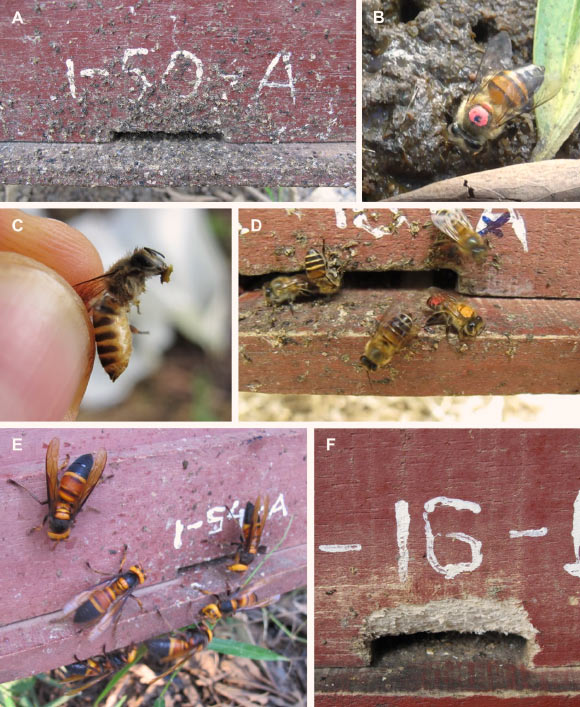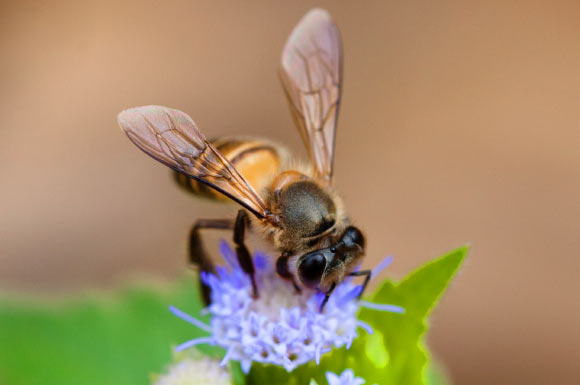In a paper published this week in the journal PLoS ONE, an international team of researchers described an extraordinary collective defense used by eastern honeybees (Apis cerana) in Vietnam against group-hunting giant hornets Vespa soror: in response to attack by the hornets, eastern honeybee workers foraged for and applied spots of animal feces around their nest entrances.
Honeybees, famous for the resources that their prolific colonies sequester, provide an impressive example of the diversity of nest-defense strategies that have evolved within a geographically widespread group.
Because of their ability to respond to threats collectively, honeybees exhibit varied and often spectacular suites of defensive responses to counteract the predatory pressures that different species face.
Honeybee nests attract an array of vertebrate and invertebrate predators, most of which are larger than bees themselves and attack colonies to prey upon adults and brood and steal stored food.
For honeybees, the true hornets (genus Vespa) are a particularly dangerous category of predator that exert tremendous selective pressure on their prey.
They hunt for insects to feed offspring that demand a continuous source of fresh prey, which can be provided in abundance by the resources in a honeybee nest.
They are superbly adapted for hunting insects like bees: they are typically larger than their victims, they have strong mandibles for crushing, dismembering and masticating prey, and, while armed with a venomous sting, they are well-armored to avoid stings themselves.
“Giant hornets are the biggest wasps that threaten honeybees. They are one of their most significant predators,” said Professor Gard Otis, a researcher in the School of Environmental Sciences at the University of Guelph.
“They raid the nests, killing the bees and carrying away larvae and pupae to feed their own developing brood.”
Professor Otis and his colleagues from Canada, Vietnam and the United States set out to explore, for the first time, the defensive response of eastern honeybees to a fearsome, but poorly studied, hornet predator: Vespa soror.
For the study, the scientists gathered dung from water buffalo, chickens, pigs and cows, and placed it in mounds near an apiary.
By the end of the day, some 150 bees had visited the piles, particularly collecting more odoriferous manure of pigs and chickens.
They marked individual bees to identify them at their hives. Minutes later, they recorded videos of the marked bees applying the material at nest entrances.
The hornets spent less than half as much time at nest entrances with moderate to heavy dung spotting as they did at hives with few spots, and they spent only one-tenth as much time chewing at the hive entrances to get at the bees’ brood.
They were also less likely to launch mass attacks on the more heavily spotted hives.
The authors are unsure just what deters the hornets, although they suspect the insects are repelled by the smell of the dung. Dung may also mask odors emitted by the bees.

Apis cerana defended their colonies from group attack by Vespa soror by applying fecal spots around hive entrances: (A) a hive front with heavy fecal spotting around the entrance opening; (B) a marked Apis cerana forager on a dung pile; (C) a forager holding a clump of fecal solids in her mandibles, captured after leaving a dung pile; (D) a forager applying a fecal spot to a hive front after being paint marked on a dung pile; (E) an entrance-focused group attack on a colony by six Vespa soror workers; (F) damage to a hive entrance after entrance margins were chewed on by Vespa soror workers (the attack was stopped by experimenters before the nest was breached). Image credit: Mattila et al., doi: 10.1371/journal.pone.0242668.
To further understand the hornets’ behaviors, the team extracted the chemical pheromone applied by hornets when marking their target hive.
When the pheromone was applied to the bees’ entrance, it prompted honeybees to apply dung to the hive.
Many scientists disagree over whether certain animals — let alone insects — use tools.
To qualify as tool users, animals must meet several criteria, including using an object from the environment — in this case, dung.
“The bees clearly use the material to alter the hive with purpose,” Professor Otis said.
“And they shape and mould it with their mouth parts, which he said meets the test of holding or manipulating a tool.”
“This study demonstrates a fairly remarkable trait these bees have to defend themselves against a really awful predator,” said lead author Professor Heather Mattila, a researcher in the Department of Biological Sciences at Wellesley College.
_____
H.R. Mattila et al. 2020. Honey bees (Apis cerana) use animal feces as a tool to defend colonies against group attack by giant hornets (Vespa soror). PLoS ONE 15 (12): e0242668; doi: 10.1371/journal.pone.0242668








